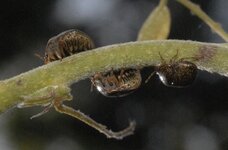
They might be small in stature, but kudzu bugs are quickly becoming a big -- and smelly -- problem across the South. In fact, entomologist Wayne Gardner at the University of Georgia at Athens, says their arrival and the recent discovery of a parasitic enemy that specifically targets the insects is like something out of a Michael Crichton novel.
"They are not supposed to have appeared in North or South America, and they turn up on our front porch, or back porch, however you want to look at it," he says.
The tiny bugs, which look like an olive-green version of a ladybug, first showed up at Hartsfield-Jackson Atlanta International Airport in 2009. They likely came over on a plane from Asia, where they are prevalent.
Kudzu bugs are here; problem is (besides the stink), they may eat more than kudzu | timesfreepress.com







